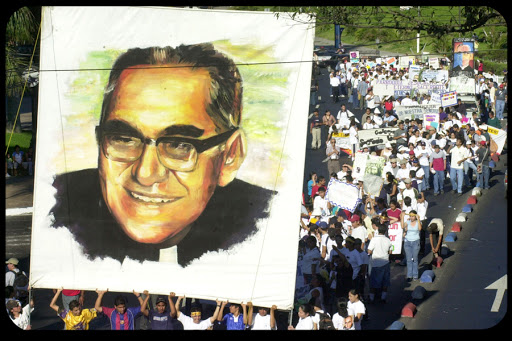I first came across the witness of Archbishop Romero when I was asked to lead high school mission trips to El Salvador. I soon came to love the country with its friendly people, beautiful countryside and the passion for their Catholic faith. However, it was clear that Archbishop Oscar Romero was a polarizing figure.
Part of the mission trip for our American high school students was to gather at my home the week before departure to watch the film on Romero’s life starring Raul Julia. When we went to San Salvador—the capital of the country—we paid a visit to the tomb of Romero in the crypt of the cathedral and then visited the small convent chapel where he was murdered. His simple four room apartment on the premises is now a museum to his life and ministry.
Romero was an unlikely controversialist. Brought up in a poor family, he completed his education at seminary and went to Rome to study. Eventually he moved up in the hierarchy in San Salvador, being seminary rector, editor of the archdiocesan newspaper and then auxiliary bishop of San Salvador, bishop of Santiago de Maria diocese and finally Archbishop.
His appointment as Archbishop was greeted with dismay by liberation theologians because Romero was well known as a conservative. He was Rome’s man and no friend of the Marxist inspired theology spreading across central and South America. Too often the church had been seen to be complicit with the right wing dictatorships—remaining silent in the face of oppression of the poor and seeming to be in the pocket of the few powerful families who controlled El Salvador.
If he was not seen as being part of the ruling elite, Romero was considered to be a safe pair of hands who would not challenge the status quo. This changed when a personal friend Fr. Rutilio Grande was assassinated. Romero said later, “When I looked at Rutilio lying there dead I thought, ‘If they have killed him for doing what he did, then I too have to walk the same path.’”
In 1979 the Revolutionary Junta took power in a military overthrow of the government. Right wing in its ambitions, it was supported by the United States. The country was plunged into a horrible civil war with atrocities on both sides. Archbishop Romero protested the military government’s crackdown, wrote to President Carter pleading with him to stop U.S. support of the junta, and in March 1980 he was gunned down while celebrating Mass.
Archbishop Romero was on the side of the poor. While he is often linked with liberation theology because of his defense of the oppressed and his friendship with Jesuits who were liberation theologians, there is no evidence that he was himself a liberation theologian.
Pope St. John Paul II—a great critic of liberation theology—championed Romero’s cause, visited his tomb and declared him “Servant of God”—the first step to canonization. His cause for canonization has not been delayed by his association with liberation theology but because the process usually takes time and because the Vatican continued to monitor the situation in El Salvador—realizing that a rapid canonization might cause further unrest in the country and be seen as validation of liberation theology in the popular mind.
The church always has a preferential option for the poor, but her objection to liberation theology is that it filters the gospel of Jesus Christ through an exclusively Marxist lens. The saving gospel of the Lord is reduced to the class struggle and helping the poor and fomenting social change replaces the saving message of Jesus Christ and his church. In other words, liberation theology replaces the eternal message of salvation with an ideology that seeks only to make this world a better place.
Like all heresies, liberation theology is not completely wrong, rather incompletely right. A heresy is a partial truth or a distortion of the truth. In this case, the church’s love for the poor and compassion for the suffering—which is properly the result of being transformed by the saving grace of following Christ—has replaced the primary mission of the church, which is the salvation of souls. In other words, they have put the second great commandment (to love your neighbor) in front of the first (to love God). As a result priests become social workers, politicians and revolutionaries rather than the pastors of souls.
Archbishop Romero was on the side of the poor. He criticized oppressive governments. He called for peace and justice, but first and foremost he was a holy priest. In his diary on 4 February 1943 Romero wrote, "In recent days the Lord has inspired in me a great desire for holiness…. I have been thinking of how far a soul can ascend if it lets itself be possessed entirely by God.” His love for the poor, his simple life and his final martyrdom confirms that Oscar Romero had the right priorities: First to love God, and in response to love his neighbor.
Fr Dwight Longeneckeris parish priest of Our Lady of the Rosary, Greenville, South Carolina. Visit his blog, browse his books and be in touch at dwightlongenecker.com

